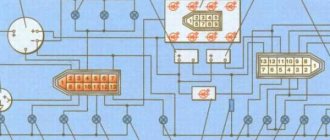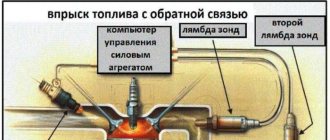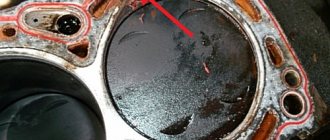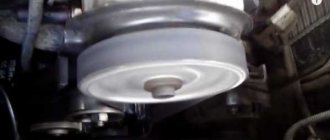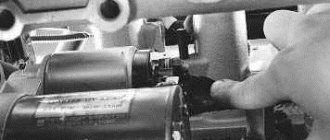What could happen to the car due to poor ground contact?
With the electrical equipment of any vehicle, malfunctions can occur that seem to people far from electricians to be the work of evil spirits.
And the culprit of mysterious malfunctions in the electrical equipment of a motorcycle or car, in most cases, is poor contact of the negative terminals - “ground”. But let's take things in order. Many drivers know that the method of connecting electricity consumers to a power source (generator or battery) on any vehicle is single-wire. The second (negative) wire is the body of a car or the frame of a motorcycle (trike, scooter, ATV, etc.). The very idea of connecting the negative side of a power source (battery) to a steel frame or body is quite old and natural, as it can significantly simplify, lighten and reduce the cost of any vehicle.
A separate ground wire is used to connect the engine to the body or frame, since the engine hangs on rubber mounts that do not allow current to pass through, while both plus and minus are required by the starter, and, for example, by the carburetor solenoid valve. On foreign cars, especially injection ones, there may be even more consumers requiring electricity (and, accordingly, plus and minus). But the positive wires usually begin and end with quite reliable terminals, which are usually in completely sealed plastic blocks or rubber covers, but the negative wires are attached to the body or frame according to the principle “some water will find a hole.” And the body itself, in the place where the hole is drilled and the negative wire is secured, begins to rust very quickly, unless, of course, appropriate measures are taken immediately.
In addition, many do not take into account another important fact, which is known even to a novice electrician: aluminum and copper terminals cannot be connected to each other, since these metals, to put it mildly, are “not friendly” with each other, and begin to oxidize intensively. How can oxidized parts have normal contact? But I often see on the vehicles of inexperienced drivers, on the aluminum housing of the gearbox or engine head, a screwed-on copper terminal of the negative wire, which, in addition, is also washed by streams of water in bad weather.
A steel body or frame is also not friendly with copper, like aluminum, and forms an electrochemical couple. And the saddest thing about this is that the steel in such a connection will be blown away by two people and will corrode several times faster. As a result, the contact disappears (or there is a significant loss of current). Standard terminals installed at the factory are usually tinned. But under a thin layer of tin, which is easy to tear off when installing the terminal, there is still the same copper alloy.
Based on the above, it is obvious that the negative connections themselves to the body or frame are initially less reliable than the copper wires themselves and their copper terminals (tips). Now imagine, for example, in order for electricity to reach the carburetor solenoid valve, the electric current must go along a copper wire (copper bus) from the battery to the body, then along another wire to the engine, then along the intake manifold studs and their threads, often coated with sealant (or the studs are rusty), and finally go along the threads of the solenoid valve itself. Loss of contact in any of the listed places - and the circuit is open, and hence a whole bunch of malfunctions. As a result, the inexperienced driver is surprised - why did the carburetor suddenly begin to work poorly and gasoline consumption increase? You need to go to a carburetor specialist or buy another carburetor. But usually few people know that in such a situation the carburetor has nothing to do with it. And I gave one example of a sudden malfunction, but there can be many of them.
Therefore, in modern cars or motorcycles, full-fledged negative wires are increasingly used, because modern on-board electronics will not work without them, and most devices or programs will fail. On such equipment, reliable contact is especially important. Experienced electricians know, and I have already said this: in electrics there are only two faults - there is a contact where it is not needed, and there is no contact where it is needed.
Typical malfunctions on a car due to poor ground contact (but not all, we read about the rest below) .
These malfunctions, as I already said, seem like miracles to inexperienced drivers. It is not uncommon at a factory (especially a domestic one) to place the negative terminal of the headlight on a stud or bolt securing the headlight housing to the body, and then tighten it with a nut. At first glance, many will think that everything is correct, because the stud or fastening bolt is welded to the body. But the headlight housing is made of soft plastic, and the nut on the terminal cannot be tightened properly, otherwise the plastic will crack. In the end, it only takes a short drive on our roads to weaken such contact to the point of its complete absence. But in a standard headlight with a modest lamp of 55-60 watts, the current consumed even by such a lamp is quite large - up to 10 amperes (if both its threads are energized, both high and low beam).
In the end, a bad contact, if it does not disappear completely, will burn out, the resistance of such a connection will increase even more, and from a school physics course we know that the greater the resistance, the more heat is released when current passes in this place. This means that the burning of contacts will intensify even more (a vicious circle), and it’s not far from a fire (plastic burns well). And many young novice drivers, instead of a standard 50-60 watt lamp, install a hundred (100 watt), which consumes even more current. The consequences can be dire.
A few words about electrolyte
The main parameter that determines the voltage level in the battery is the density of the electrolyte that is inside this device.
When the battery is discharged, acid is consumed, the share of which in this composition is 35 - 36%. As a result, the density level of this liquid decreases. During the charging process, the reverse process occurs: water consumption leads to the formation of acid, which results in an increase in the density of the electrolytic composition.
In the standard state at 12.7 V, the density of this liquid in the battery is 1.27 g/cm3. If any of these parameters decreases, the other also decreases.
.3.3. Poor Ground Detection
The negative terminal of the battery is connected to “ground” - the metal of the body, engine or gearbox; Moreover, many elements of electrical equipment are connected in such a way that only the positive wire is suitable for them, while the current returns to the battery through the metal of the body. This means that the electrical component mount and the body are part of the electrical circuit. As a result, poor or corroded fasteners can cause the element to fail or cause it to perform erratically or poorly. In particular, light bulbs may glow dimly (especially if the light bulb's ground point is connected to another electrical component that is still on), electric motors may run slowly, and the operation of one circuit may have a seemingly unnoticeable effect on the operation of another circuit.
Don't forget that many vehicles use ground wires between certain components such as the engine/transmission and the body, that is, in areas where there is no direct metal-to-metal contact due to soft rubber mounts or a layer of paint.
To check the reliability of the element's grounding, it is necessary to disconnect the battery and connect one of the ohmmeter probes to a reliably grounded element. Connect another probe to the wire or connection to the body that needs to be checked. The resistance shown by the ohmmeter should be zero; if not, check the connection as follows.
If you suspect there is no ground, disassemble the connection and clean the body area and wire terminal (or the grounding surface of the element) to bare metal. Carefully remove all traces of dirt, then use a knife to remove all paint so that there is reliable contact between the two metal surfaces.
Also interesting: What is the difference between the Niva Urban and the regular Niva?
When assembling, tighten the connector securely; When connecting a wire terminal, install a serrated washer between the terminal and the body surface to ensure a secure connection. When connecting, prevent future corrosion by applying a layer of Vaseline or silicone grease.
Under load
Voltage can be divided into three main indicators:
If we talk about the nominal voltage , by the way it is usually indicated in literature and other materials, it is equal to 12V, but this indicator is actually far from the actual parameter, I am silent about the load.
As we have already said, the normal operating voltage of a passenger car battery is 12.6 - 12.7 volts. But in fact, the actual indicator is more reliable, which can range from 12.4 volts to approximately 12.8 V. I want to emphasize that this parameter is taken without load, which is said at rest.
But if we apply a load to our battery, the parameters will be completely different. The load is mandatory, this test shows the battery’s performance, because often all batteries can withstand normal voltage, but “dead” ones cannot withstand the load.
The essence of the test is simple - a fully functional battery is placed under a load (using a special device - a “load fork”) that is twice its capacity.
That is, if you have a battery with a capacity of 60 Am/h, then the load should be 120 Amperes. The duration of the load is approximately 3 - 5 seconds, and the voltage should not drop below 9 Volts; if the indicator is 5 - 6, then your battery is either discharged or almost dead. I would also like to note that after the load, the voltage should recover in about 5 seconds to the normal value, at least 12.4.
When there is a “sag”, the first thing you need to do is charge the battery, and then repeat the experiment with the “load fork”; if a large sag is not noticed, then the battery needs recharging. Watch a video about testing under load.
Where is the mass of the Chevrolet Niva engine?
But if everything is in order with the relay, and the devices do not work, then there may be a problem elsewhere - the mass attachment point. The negative wire coming out of the battery is connected to the car body and goes to some of the main energy consumers in the form of wires. This is sometimes the difficulty when calling an electrician.
The architecture of the circuit can be described as follows: a wiring harness comes out of the negative terminal, connecting devices operating from one ground point, then wires connecting other ground points are connected to them using a crimp sleeve. As a result, finding a specific mass attachment point is quite difficult.
For example, the mass of the mirror control unit is located behind the trunk trim. But with the engine everything is a little simpler. Since it is connected to the frame and body through pads, which are essentially a dielectric, it has its own wiring harness. The terminals are located on the left side of the engine, below the ignition module. They are responsible for the operation of the ECU and ECM sensors.
Why do they do the de-mining?
During the operation of the car, you may encounter the fact that the electrical on-board network literally “sags,” especially at times of peak loads (simultaneous activation of the dimensions, low and high beam headlights, various heated mirrors and windows in parallel with the use of the air conditioning system, electric windows, powerful acoustics and other devices).
Also, voltage dips can occur for no apparent reason, affecting the stability of the internal combustion engine, its ignition system, ECU, sensors, servos and other electrical devices. This can happen if oxidation has occurred in the place where the negative terminal is normally attached to the body, the contact has broken down, or corrosion has appeared. The automobile electrical network naturally begins to operate unstably.
In the first case, additional demining of the engine is often necessary due to the fact that the car body is old, the standard place for attaching the mass has become unusable, etc. Regarding improvements and tuning, there is an opinion that additional de-mining allows a more even distribution of electricity in the vehicle’s on-board network compared to using the standard negative terminal.
Solutions to the problem
If power outages occur frequently or current leakage occurs during long periods of parking, you can improve the system to solve the problem. It’s not difficult to get the job done; the minimum set of tools that every motorist should have is enough. The procedure depends on the nature of the malfunction.
How to make mass better
If removing and cleaning the contacts does not produce any effect, you will have to use more radical repair methods. In some models, the problem with a minus on the body is a real “disease”, so it is necessary to improve the design in order to eliminate the manufacturer’s shortcomings:
It is necessary to monitor the condition of the wires and replace them if there is even the slightest doubt about reliability. It is best to use the same elements as those installed, plus high-quality fasteners.
Installing the mains switch
The switch will protect the car from current leakage, short circuit, and can also serve as an additional anti-theft system. It’s easy to install it yourself; most often, one of two options is used:
The switch is not suitable for cars with an alarm and central locking, since if there is no ground, the system will not work. It is also undesirable to install it on models with a lot of electronics.
It is not difficult to locate the ground wires; they should be periodically removed and processed to ensure good contact. When checking, it is better to use a multimeter, this is the easiest way to detect damage if it is present. It is recommended to replace worn wires in a timely manner, and to prevent leaks, you can install a power switch button.
Reduce voltage in winter
Car owners often complain that in winter, when there is severe frost, the main parameters of the battery drop, as a result of which the car does not start. Therefore, some drivers take the battery into a warm place at night.
But in reality, things are not quite like that. At negative temperatures, the density of the electrolyte changes, which, as already noted, affects the voltage level. But if the battery is sufficiently charged, the density of the electrolyte increases in cold weather, and as a result, the second of the most important properties also increases. Therefore, a sufficiently charged battery is not in danger even in severe frost. If you leave it discharged in cold weather, the density of the electrolyte will decrease, which will result in problems starting the car engine, possibly even freezing.
Problems with using and starting a vehicle’s power unit in winter are not associated with a decrease in the basic parameters of its battery, but with the fact that the main chemical processes inside it at negative temperatures are slower than in normal times.
Therefore, with a normal charge, the density and voltage of the battery will be sufficient to start the car engine even in winter frosts.
Now a short video.
This is where I end the article, I think it was informative, read our AUTOBLOG.
(
79 votes, average: 4.33 out of 5)
Where is the ignition relay located on a Niva Chevrolet?
The ignition relay is located in the passenger compartment fuse box; it can be found on the driver's side of the instrument panel, opposite the seat. On the diagram it is usually designated K6 and in the technical description it is sometimes called an addition relay.
Also interesting: Niva-Chevrolet with an Opel engine: brief description, technical characteristics, owner reviews
It is responsible for turning on the fuel pump and supplying voltage to other elements. Triggered when the ignition key is turned. At this moment, you can hear a click behind the instrument panel. This electric coil built into the relay receives voltage and closes the contacts of a certain circuit. If there is no characteristic sound when turning the key, this may indicate its failure.
Standard for basic battery properties
What minimum value should this value be in order to start the engine? There is no exact indicator here. In the standard state, this property for a fully charged battery should average 12.6-12.7 volts.
Depending on specific conditions, this indicator may vary slightly, and there is nothing wrong with that. For example, some manufacturers assure that their products have a voltage of about 13 - 13.2 V, this is acceptable, but I want to warn you right away.
ADDITIONAL MASS WIRES
If the weight of the engine with the body is bad, then problems arise:
When symptoms of poor engine weight appear, there is a way out of the unpleasant situation - in this case, additional weight on the engine will help. You can install an additional wire in different ways, the most important thing is that it reliably connects the car body with the power unit. For example, one end of the wire can be attached to the stud of the upper shock absorber support, and the other to the stud of the intake manifold of the internal combustion engine. It is important that the wire has a large cross-section, preferably no less than that of the bulk itself.
On new machines, problems with mass wires rarely occur. But on older models, the body studs rust. Finding a lack of ground is not so easy, so car owners use the installation of additional wires. So the additional mass on the generator helps eliminate battery charging leakage.
Battery leakage current
The situation when the battery is discharged overnight so that the engine is difficult to start is familiar to many. The reason is the high leakage current of the car battery. During idle time, the battery self-discharges and parasitic currents in the vehicle circuit consume energy. An article about how to identify hidden consumers and eliminate current leakage, identify acceptable energy consumption in a car during idle time and not drain the battery

